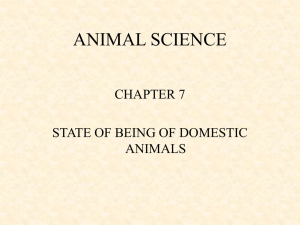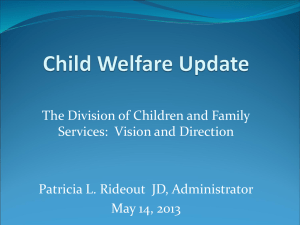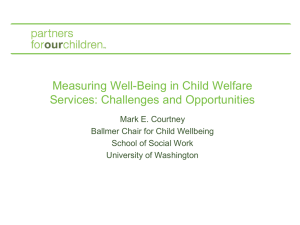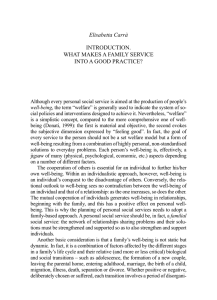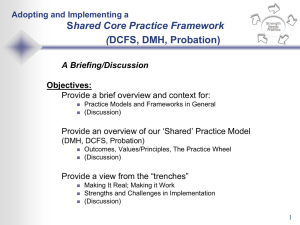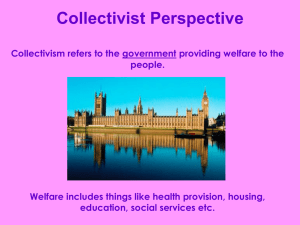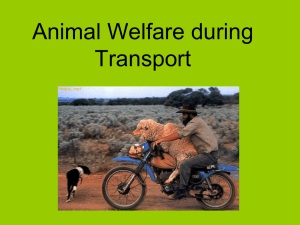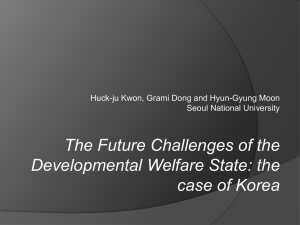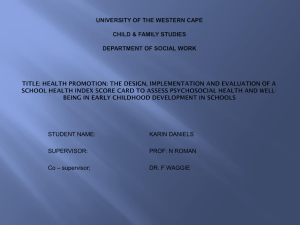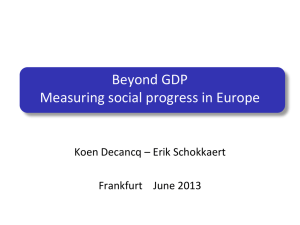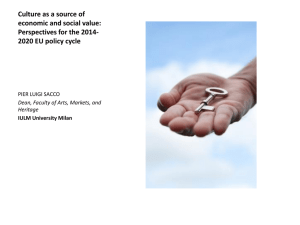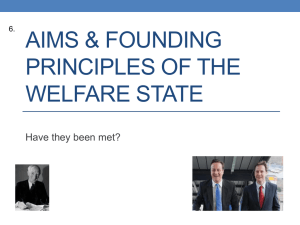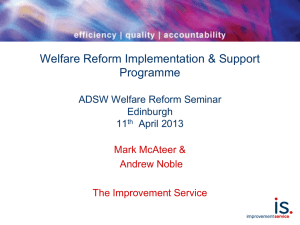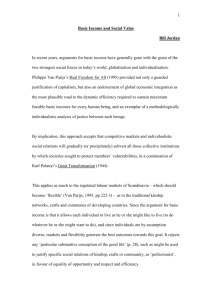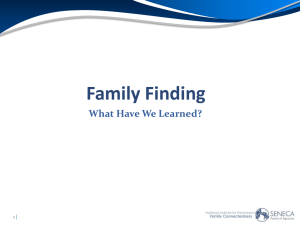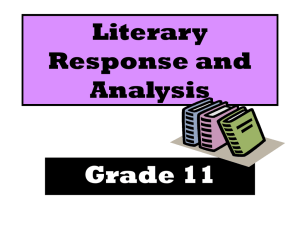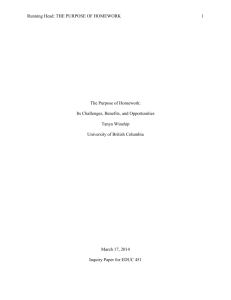Inter-agency data sharing and protection: Measuring child well
advertisement
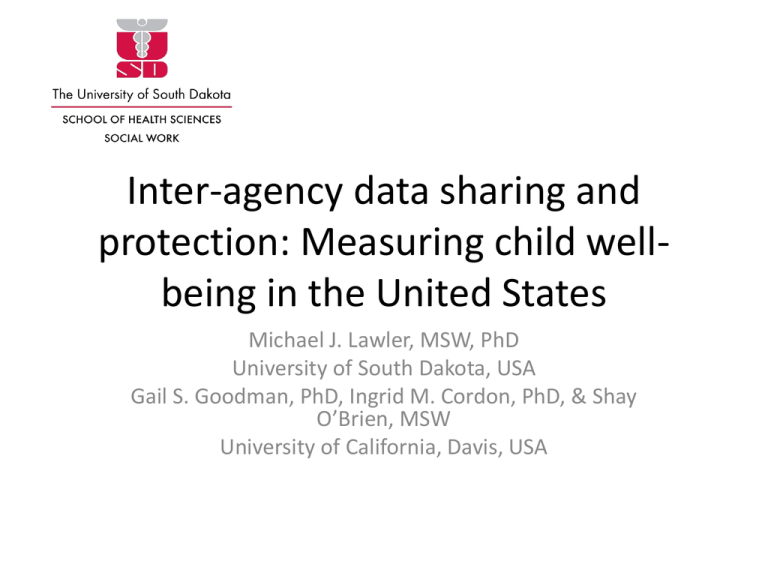
Inter-agency data sharing and protection: Measuring child wellbeing in the United States Michael J. Lawler, MSW, PhD University of South Dakota, USA Gail S. Goodman, PhD, Ingrid M. Cordon, PhD, & Shay O’Brien, MSW University of California, Davis, USA Measuring child well-being for child welfare services in the US Adoption and Safe Families Act (1997) + Child Welfare Indicators Research (e.g., Land et al., 2001) + Evidence Based Practice (e.g., IOM, 2001)+ Belief in the impact of data (e.g., O’Hare, 2008) = US Child and Family Services Reviews (first round completed in 2004) Child and Family Service Reviews (CFSR) for child welfare services • Safety – Lack of abuse, neglect • Permanency – Home with family, adoption • Family and Child well-being – Health, Education, Mental Health, Criminal history • Plus, many states adopted additional measures and operational definitions • No state met all CFSR standards for safety, permanency, & well-being Project Description • California Department of Social Services contracted with the University of California, Davis for two phases of the project: – Phase I: Inter-agency data sharing between California Health & Human Services state and county (58 counties) agencies (Wilson, Goodman, & Lawler, 2006). Can we? – Phase II: Data sharing and linkages between agencies and national best practices (Goodman et al., 2009). How can we? Methods • Review of research literature and federal and state regulations • Structured interviews with county, state, tribal, and national agencies • Case studies review • Expert panels Different levels of measuring child welfare outcomes • Safety – Federal reporting of child abuse and neglect (individual and aggregate)* • Permanency – Federal reporting of federally supported child placements (individual and aggregate)* • Well-being – Decentralized across jurisdictions (states, counties, cities, school districts). Some data have federal reporting (mostly aggregate) • *Measured well by UC Berkeley Decentralized social welfare agencies • California as an example: • Health & Human Services – – 6 state agencies (Mental Health, Social Services, Alcohol and Drug Programs, Developmental Disabilities, Health Care Services, Public Health) – 58 counties with those same agencies – Overall population of 36 million – 90,000 children in out of home care (foster care) Decentralized education • California as an example: • Education – State department of Education – 58 county Education offices – Approximately 1,000 school districts and 9,000 schools – 7 million students Protections for child well-being data • Health Insurance Portability and Accountability Act (HIPAA) – Protects healthcare information • Family Educational Rights and Privacy Act (FERPA) – Protects educational information • Both protect rights but can prevent agencies from sharing with each other, especially when not mandated to share Data challenges for agencies in the US • Legally, agencies cannot act outside the power delegated to them under statute (Dawes, 1996) • HIPAA and FERPA, and potential litigation, inhibit broader interpretations of statutes • “Data people” and “program people” designations may affect data quality • Departmental and professional silos Data sharing solutions • Re-conceptualize data sharing in terms of both client-oriented and operations-oriented to reflect program and data • Direct connections between case management and performance management contribute to better data quality and commitments to data sharing • Example - San Diego County, California Data sharing solutions • Short-range goal setting – Memoranda of Understanding between entities – Court-ordered agreements – HIPAA Business Associate Agreements – Small, focused data workgroups – Sampling for some measures – Examples – Los Angeles County, Santa Clara County, California Data sharing solutions • Long-range goal setting – Federal and state level advocacy for reinterpretation of statutes – Greater standardization of data elements, collection processes, and languages – Investment in human resources for data management – Bringing together technology, policy, and legal, as well as political will – Example – Colorado’s “Virtual Court” Data sharing solutions • Use of Centralized Date Warehouses – Can be used as one-stop option for multiple data sources entered and matched confidentially for individual and aggregate data (McDonald & Associates, 2008) – Examples – Allegheny County, Pennsylvania, National Center for Health Statistics, Department of Health Care Services, California References • • • • • • • • Adoption and Safe Families Act (1997). Public Law No. 105-89, 42 USC § 1305. Dawes, S. (1996). Interagency information sharing: Expected benefits, manageable risks. Journal of Policy Analysis and Management, 15, 377-394. Goodman, G.S., Lawler, M.J., O’Brien, S., Wilson, K., Cordon, I.M., & Iandoli, C.C. (2009). California Department of Social Services and Child Welfare Council Data Linkages Project. Sacramento, CA: California Department of Social Services. Institute of Medicine (2001). Crossing the quality chasm: A new health system for the 21st Century. Washington, DC: Author. Land, K.C., Lamb, V.L., & Mustillo, S.K. (2001). Child and youth well being in the United States, 1975-1998: some findings from a new index. Social Indicators Research, 56, 241-320. McDonald, W.R., & Associates (2008). Analysis of existing data collection programs and data warehouse efforts. Report submitted to Casey Family Programs on March 28, 2008. Sacramento: Author. O’Hare, W.P. (2008). Measuring the impact of child indicators. Child Indicators Research, 1, 387-396. Wilson, K., Goodman, G.S., & Lawler, M.J. (2006). Interagency measurement of child well-being. Sacramento, CA: California Department of Social Services.

